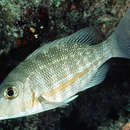Diagnostic Description
provided by Fishbase
The body is light tan or olive to brown, becoming lighter below. the centers of the scales are often lighter than the background color. The head, often, has several broad indistinct vertical and diagonal light and dark bands. Sometimes there are white spots below the eye. The posterior edge of the operculum is dark brown. An orange-yellow stripe is on the lower part of the side with two additional more faint orange-yellow stripes above and one below this stripe. The fins are whitish or tan, sometimes mottled.
- Recorder
- Estelita Emily Capuli
Life Cycle
provided by Fishbase
Gonochorism is inferred for this species as sizes of males and females overlapped and male gonad morphology is typical of secondarily derived testes (Ref. 103751). This may be supported further by the study of Ebisawa etal (2006) which characterised sexual pattern for this species as juvenile hermaphroditism indicating that sexual transition occurred before ovarian maturation, a case for non-functional hermaphroditism in Ref. 103751.
Morphology
provided by Fishbase
Dorsal spines (total): 10; Dorsal soft rays (total): 9; Analspines: 3; Analsoft rays: 8
- Recorder
- Estelita Emily Capuli
Trophic Strategy
provided by Fishbase
Occur inshore (Ref. 75154). Found over seagrass beds, sand and rubble areas of lagoons and reefs (Ref. 30573). Found singly or in groups (Ref. 9710). Juveniles on weedy reefs (Ref. 48635). Feed on mollusks, crustaceans, and echinoderms (Ref. 30573). One of the commonest lethrinids along the coast of east Africa (Ref. 4369).
Biology
provided by Fishbase
Found over seagrass beds (Ref. 41878), sand and rubble areas of lagoons and reefs (Ref. 30573). Found singly or in groups (Ref. 9710). Juveniles on weedy reefs (Ref. 48635). Feed on mollusks, crustaceans, and echinoderms (Ref. 30573). One of the commonest lethrinids along the coast of east Africa (Ref. 4369). Marketed fresh (Ref. 9775).
Importance
provided by Fishbase
fisheries: minor commercial; price category: very high; price reliability: very questionable: based on ex-vessel price for species in this family
分布
provided by The Fish Database of Taiwan
分布於印度-太平洋區,西起東非、紅海,東至薩摩亞、東加,北至日本南部,南至澳洲。台灣分布於南部及東沙海域。
利用
provided by The Fish Database of Taiwan
一般以延繩釣、一支釣或底拖網等方式捕獲,全年都可以捕撈到。
描述
provided by The Fish Database of Taiwan
體延長而呈長橢圓形。吻短而鈍。眼間隔凸起。眼大,位於近於頭背側。口端位;兩頜具犬齒及絨毛狀齒,後方側齒呈圓形而有犬齒尖或臼齒但呈塊狀;上頜骨上緣平滑或稍呈鋸齒狀。頰部無鱗;胸鰭基部內側具鱗;側線鱗數46-47;側線上鱗列數5.5。背鰭單一,不具深刻,具硬棘X,軟條9,第IV或V棘最長;臀鰭硬棘III,軟條8,第1軟條通常最長,但等於或短於軟條部之基底長;胸鰭軟條13;尾鰭分叉,兩葉先端尖型。體呈淺黃褐色或淡橄欖綠,體側下半部有一條明顯橙黃色縱帶,有時顯橙黃色縱帶之上下方另具有不顯之縱帶;鱗片中部較淡色於周圍;頭部通常具多條不顯之斜帶;鰓蓋緣為暗褐色;眼下方有時具少許白色點。各鰭淡色或淡灰,有時具雜斑。
棲地
provided by The Fish Database of Taiwan
主要棲息於沿岸珊瑚礁、岩礁區外緣、沼澤區、紅樹林區或海藻床區,主要分布的深度在10-75公尺。獨居或成小群活動,主要以軟體動物、甲殼類及小魚為食。
Lethrinus obsoletus
provided by wikipedia EN
Lethrinus obsoletus, the orange-striped emperor, is a species of bony fish in the family Lethrinidae.[3]
References

- license
- cc-by-sa-3.0
- copyright
- Wikipedia authors and editors
Lethrinus obsoletus: Brief Summary
provided by wikipedia EN
Lethrinus obsoletus, the orange-striped emperor, is a species of bony fish in the family Lethrinidae.
- license
- cc-by-sa-3.0
- copyright
- Wikipedia authors and editors
Description
provided by World Register of Marine Species
Found over seagrass beds, and sand and rubble areas of lagoons and reefs. Feeds on molluscs, crustaceans, and echinoderms. In Palau, it is known to spawn at the outer reef edge on the first five days of the lunar month, from November through April (Ref. 2295). Also caught with beach seines and handlines and is marketed fresh (Ref. 9775).
Froese, R. & D. Pauly (Editors). (2023). FishBase. World Wide Web electronic publication. version (02/2023).
- license
- cc-by-4.0
- copyright
- WoRMS Editorial Board

